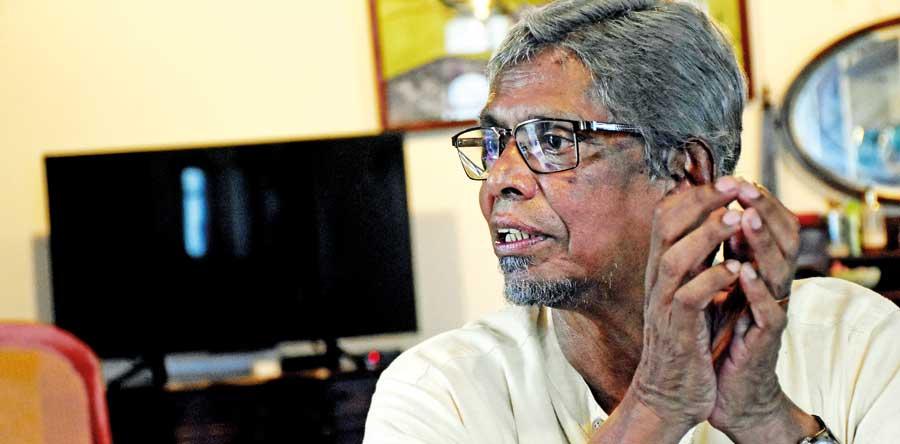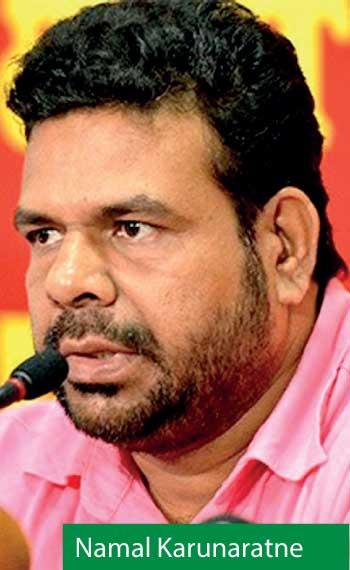Import of nano-Nitrogen fertiliser: Sri Lanka breathes sigh of relief; but farmers still in the dark
Posted on October 29th, 2021
Courtesy The Daily Mirror

As soon as Sri Lanka rejected the consignment of organic fertiliser from China, India took immediate steps to come to Sri Lanka’s rescue. In response, the Government of India sent the first consignment of 3.1 million litres of nano nitrogen fertilizer from Indian Farmers Fertiliser Cooperative Ltd. (IFFCO) to be sent to the Eastern Province for the cultivation of maize and paddy. However, shocking revelations by several opposition Ministers have raised concerns about the financial transactions done with regards to this consignment. Recently JVP Parliamentarian Vijitha Herath said in Parliament that Sri Lanka has allegedly deposited USD 1.275 million to a private account under the name ‘United Farmers’ Trust Limited’. However, in response Agriculture Minister Mahindananda Aluthgamage claimed that it was the Indian High Commission that facilitated the fertiliser imports and that IFFCO has appointed the ‘United Farmers’ Trust Limited’ as the local representative. But even if the two governments have sealed the deal, local farmers are yet to see the light at the end of the tunnel as no proper directions have been given on the associated risks of these products or how these should be used in farmlands.
An impossible task?
But academics attached to Agriculture and Technology Faculties in state universities pointed out that this fertiliser is a urea-based formulation where urea is coated with polymers to make nano-size particles. As such it is a synthetic chemical fertiliser and not an organic fertiliser.
Issuing a statement under the Federation of University Teachers’ Association letterhead the academics point out that it is a rather new product that has very recently received approval for large scale production from India’s Ministry of Agriculture. The statement further reads that the Ministry claims that three applications of 2.5 litres of this fertiliser at a time is adequate to provide required nutrients for the cultivation of one hectare of paddy crop. But the academics underscored that in general, nearly 105 kg of nitrogen is taken up by the paddy crop yielding 4-5 tons of grains per hectare. As such, nano-nitrogen fertiliser should be applied at a rate of 1250 litres per hectare if it is the only source of nitrogen added to the crop.
This is an impossible task to be realised within a cropping season. On their official website, IFFCO has indicated that this nano-nitrogen fertiliser should be applied only as a top dressing along with a reduced rate of urea, while phosphorus and potassium sources are to be supplied at full rate as per the recommendations,” the statement read.
It further sheds light on the lack of SLS standards in Sri Lanka for nano fertilisers. These standards should be developed to assure the quality of the product, free of biurate-like toxic substances. Furthermore, in the eco-friendly/green agriculture concept, much attention is given to improve and regenerate soil fertility. However, the foliar application of fertilisers will not contribute to enhance soil fertility and will result in lower yields.

Prof. Athula Perera
Pix by Kushan Pathiraja
“At present, the government is in the process of bringing down nano fertiliser. When we take nanoparticles they are so small and you can do wonders with it. But every technology comes with a risk”

We need all information about these nano fertilisers : Prof. Athula Perera
The importation of live material to Sri Lanka although is restricted by the law has now become the only option with the government’s move to transform into an organic nation. Expressing his concerns on the usage of nano fertiliser, Prof. Athula Perera of Peradeniya University said that the government needs to provide all the information about these fertiliser products. Prof. Perera has been involved in formulating the National Biosafety Framework when he was appointed as the National Coordinator for the project back in 2003. At present he is a consultant in Biosafety to the National Science Foundation.
Excerpts :
Q Tell us about biosafety practices and Sri Lanka’s stand on this subject.
The first commercial production of genetically modified plants came into the scene back in the 1990s. Even until now, nobody is absolutely certain that there are risks in Genetically Modified Organisms (GMOs). So when you’re uncertain you apply what is called the precautionary principle. Hence the UN Convention on Biological Diversity appointed a special committee to look into this and this committee met in Cartagena in Colombia and came up with the Cartagena Protocol for Biosafety of GMOs. In the case of GMOs we call it biosafety and not biological safety which refers to ecosystems etc. but the principles are the same. In 2003 the Environment Ministry received a grant to set up a framework for biosafety. More than 170 countries signed this framework. For GMOs we must have a policy and an administrative system. Most importantly a risk assessment procedure. If it is certain you don’t need to do it. But because of this uncertainty do a risk assessment.
Q What happened to Sri Lanka’s Biosafety Act?
From 2003-2006 we also started drafting Biosafety Act but even in 2021 this still hasn’t reached the parliament. It still has some grey areas. So how can this country progress? When there’s uncertainty it’s the right of any country to conduct a risk assessment. We have listed out how to do it.
Q Is there a risk in bringing down organic or nano fertiliser?
At present, the government is in the process of bringing down nano fertiliser. When we take nanoparticles they are so small and you can do wonders with it. But every technology comes with a risk. I don’t say we don’t want it or to send it back. I’m only giving the scientific risks involved. If there are risks then they need to be assessed and after assessing these should be managed. As I see it this can be done but not in this way.
In terms of the organic fertiliser shipment, the country of export says that they have done an examination. But how did they do it? There are large containers of compost. It’s a biological material. There are reactions happening inside. How did they take samples? Whether it is from the top or bottom? Therefore you need a statistician and ask how a sample could be obtained. Sampling itself is a huge task. When they are put into packets the contents of one packet is different to the other.
Q What is the correct approach?
There are accepted risks of nanomaterials to the environment and human health. The research on nanomaterials is still at the laboratory level. Therefore we are uncertain. What many people including scientists forget is that this is a unique country and it is very small. Then any risk is so many folds more effective and dangerous than any other larger nation. There are three components to a risk assessment – the hazard that causes the damage, exposure to the hazard and the consequences. In the case of nano fertiliser, the hazard that could cause damage is the nanoparticle. Then we must know everything about this particle. We must know what it is made up of; whether it is gold, silver or copper. We need to know the size and shape of this particle. Those who made this know it and therefore it’s not difficult to get this information. Which laboratory and when it was made should also be made public. We need a dossier that gives all this information.
When it comes to exposure we need to know how this fertiliser will be utilised. If you’re using a hand spray you can educate the farmer on how it could be done by analysing wind patterns. If you use a helicopter the exposure is bigger. Our farmlands are small and it will be exposed to larger communities. These contents could mix with water. Then there are children, the elderly, pregnant women and animals we need to consider. How do you spray it and who will spray it is another concern.
Q Who should be doing this risk assessment?
We have experts including microbiologists, soil scientists who have the expertise. The Agriculture Director-General should appoint a committee and that committee will have to do this risk assessment. They have to take this hazard and consider where it will be sprayed, who will spray it, during which season, what are the quantities, how it would be washed etc. They have to assess all these and submit a report. Communication is very important. Farmers and communities need to be informed. The media has to inform people. Otherwise, it will be extremely fearful and we wouldn’t even know what would happen. Then the exposure to humans should be assessed by medical experts. Our farmland ecosystems are different to those from India. We must never forget that a hazard can move across a country since it is very small. For example, look at the difficulty in controlling the Covid virus.
The wind, rain, humans and even birds can take these particles. Nobody knows much about the substance and therefore it could be misused unknowingly. This committee should also be clear about the birds and pollinators. There’s a method of calculating the risk and you could say if the risk is high or medium or low. Then they can advise on how it could be managed. The committee cannot give a recommendation but they can give a report. Then only the Director-General can act upon it.
If this Act was there – it is only for GMOs. The Food Act prevents any GM food from coming into the country. Whether such foods are now in the market should be tested. Is there a technology whereby we could test the water to see if there are nanoparticles? If so where is it? A little child has a lung infection and how do we know if it was caused by this? The risk lies in the fact that we are releasing it to the environment. The same procedure can be applied. It doesn’t take long to do a risk assessment. The experts sit around and calculate the risks. We want to use every technology in the country but we should use them to our benefit. This is why we have to be extremely careful.
Q Is the existing legislation sufficient enough?
The biosafety Act is only for GM foods. If you try to bring a new law it’ll take time. So we can take an existing law like the Plant Protection Act and include this risk assessment in that. That is what they did to the Food Act in terms of GM Foods.
Finally what we want to say is that we want organic food in this country. But there’s a way of doing it. Policymakers should listen to these experts. If you can’t listen to them, listen to their heart, their sentiments and emotions. They will assist in this task. The entire approach was too hasty.
“Technology Faculties in state universities pointed out that this fertiliser is a urea-based formulation where urea is coated with polymers to make nano-size particles. As such it is a synthetic chemical fertiliser and not an organic fertiliser”
“Furthermore, in the eco-friendly/green agriculture concept, much attention is given to improve and regenerate soil fertility. However, the foliar application of fertilisers will not contribute to enhance soil fertility and will result in lower yields”
“From 2003-2006 we also started drafting Biosafety Act but even in 2021 this still hasn’t reached the parliament. It still has some grey areas. So how can this country progress? When there’s uncertainty it’s the right of any country to conduct a risk assessment. We have listed out how to do it”

No directions given to farmers
The government is yet to educate the farmer communities on how they could safely utilise nano-fertilisers. We met with academics from state universities and they claim that only 4% of these nano-fertilisers contain nitrogen and that the rest is water,” said Namal Karunaratne, National Organiser of the All Ceylon Farmers’ Federation. On the other hand, this isn’t organic. It has chemicals in it. When spraying these fertilisers farmers need to wear something similar to a personal protection kit. Farmers don’t know the risk that they are exposed to when spraying these fertilisers because nanoparticles are so tiny.”
“On the other hand, this isn’t organic. It has chemicals in it. When spraying these fertilisers farmers need to wear something similar to a personal protection kit. Farmers don’t know the risk that they are exposed to when spraying these fertilisers because nanoparticles are so tiny”
He further said that since the fertiliser is saturated farmers have to spray it every four hours. Does that mean that they’ll have to keep wearing the fertiliser tanks? On the other hand, they cannot increase the concentration in order to get a higher yield because it will affect the plant in that case. The government says that 2.5 litres of nano-nitrogen is sufficient for one hectare. But university academics point out that 1250 litres are required for one hectare. Generally, you need 50 kilograms of nitrogen for one hectare of paddy. This is 20 kilograms for one acre. But the government hasn’t succeeded in providing farmers with fertilisers or ensuring that they are up to the required standards.”

A risk assessment was done in India : Dr. De Silva
Initially, 3.1 million litres of nano-Nitrogen fertiliser was imported. Another one million bottles will be imported as the second stock. I have to submit my recommendations on how these fertilisers could be used by the Agrarian Department,” opined Agriculture Department Director-General Dr. Ajantha De Silva.
“We too have started experiments on contact poisoning and it will take around two weeks to get all these results. These fertilisers should be sprayed two weeks after the crops have been planted”
When asked if a risk assessment was done on these products, Dr. De Silva said that a risk assessment was done in India. We too have started experiments on contact poisoning and it will take around two weeks to get all these results. These fertilisers should be sprayed two weeks after the crops have been planted.”
He further said that Sri Lanka has the technology to do further tests on these products.